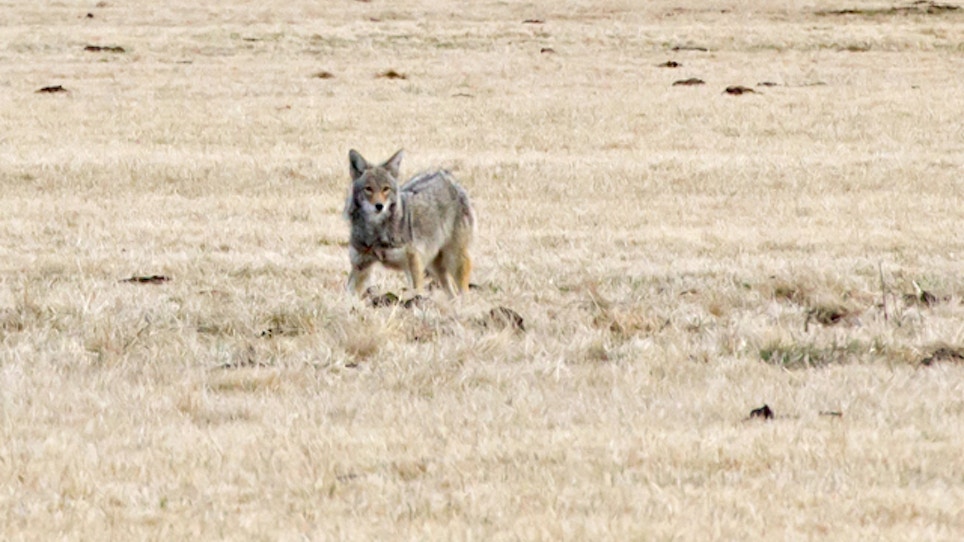
Does it matter whether you knock down coyotes with factory or hand-loaded ammo? Not to the coyote, of course. But it may make a difference to your bank account and sense of accomplishment.
The two wary coyotes were already leaving the bait pile as the eastern skies lightened. I settled behind my newly accurized Kimber Pro Varmint 22-250, which was firmly cradled on a Caldwell Steady Rest situated on the enclosed back porch at our Iowa hunting camp house.
The bait consisting of frozen deer guts and butchered carcasses was 250 yards out in the wide-open, harvested, cornfield. Through my 10X Nikon scope, I followed their retreat as the daylight shy canines trotted 150 yards beyond the bait before the distant one stopped for a brief look back and almost instantly caught a 52 grain Sierra hollowpoint boattail squarely in the chest.
The second coyote trailing 50 yards behind kicked in the afterburners at the crack of the hypersonic bullet passing overhead but when it sprinted past the downed companion in its final throes, it slowed and at 440 yards stopped, turned broadside for a brief look and caught a second .22 slug in the shoulder that anchored it. Proof positive that my long-time practice of taking the most distant critter first whenever possible pays off.
Predator shooting doesn’t get much better than that.
The Details
I had fir-lapped the barrel of the already minute-of-angle grouping Kimber and glass bedded the action, including recoil lug and three inches of the barrel to maximize the accuracy of what has become my favorite predator rifle.
The accurizing improved the groups with factory ammo down to consistently just under an inch, but when I finished testing a variety of handloads using utilizing bullets from 39 grains to 60 grains along with several different powders, the best and most consistent groups shrunk to one hole, ½-inch or less
However, the real bonus to my handloads was that the most accurate 52-grain hollowpoint boattail bullets produced by Sierra, Hornady, or Nosler, which were equally accurate and interchangeable in loading, were also the most “fur friendly.” Literally, I have shot hundreds of predators with this type of bullet, with minimal fur damage. When fur prices are high, and you hate sewing up holes, as I do, this is a definite bonus provided by fully vetted handloads.
Simply by switching from the 52-grain hollow point to a 52-grain ballistic tip or pointed soft point, which is most common in factory loadings, you may lose a smidgeon of accuracy. However, the devastating effect and amount of tissue destruction (and the size of the exit hole,) increases significantly. These are perfect bullets for predators when price and pelt damage isn’t a consideration.
OK, But Why Reload?
I would venture that a significant portion of predator hunters aren’t proficient enough shots to fully capitalize on the difference between factory and reloaded ammo, so WHY shoot reloads over factory ammo?
Col. Townsend Whelen, a well-known early gun writer, avid shooter and firearms expert with thousands of articles and many books to his credit, once stated, “Only accurate rifles are interesting. I agree with him entirely, which is the main reason I reload for all my rifles. However, I would imagine the main attraction for a predator hunter’s interest in reloading is cost.
A box of factory 22-250 ammo will range from $13 to $34 depending on brand with about a $25.00 average cost. Using new brass for the first reloading will cost, about $.50 per round, primer $.03, bullet, 52 grain .223, $.23, powder, 35 grains Hodgdon 8208XBR, $.15 per round. Total cost per load $.91 or $18.20 per box. After the first loading, you can deduct the cost of the brass, so a loaded round would cost only $.41 or $8.20 per 20 rounds — that’s about a third of the cost of factory loads.
You will need reloading equipment, and I would heartily recommend buying a complete reloading kit such as Hornady’s Lock-N-Load class kit, which has everything to get you started except the specific reloading dies for your chosen caliber or calibers. Complete starter kits such as offered by Lee, RCBS or Hornady come with a press, powder measurer, scale and assorted accessories depending on manufacturer will run from $140 to $350. The specific dies will cost in the neighborhood of $30 to $40 depending on brand and specific caliber chosen. A plethora of reloading equipment is available on E-Bay and Craigslist, and you might just luck out and find what you need at a bargain price.
The third reason for reloads over factory is the challenge and satisfaction of getting the very best out of your predator rifle and in the process yourself. I would venture that by having unlimited access to ammunition and the wherewithal to thoroughly test and fine-tune your predator rifle/ammo combo to maximize their capabilities to a finite degree at a reasonable cost, you will find yourself spending more time shooting and testing loads.
This quality time, worthwhile effort and shooting knowledge can’t help but tune your shooting skills and undoubtedly whet your enthusiasm as it increases your success and self-satisfaction with the results of your shooting and predator hunting ventures.
Make the next time a wary predator hangs up suspiciously at 400 yards or lopes out to that distance and stops to gloat on their escape and evasion success, their last with a handload! Predator hunting doesn’t get any better!





